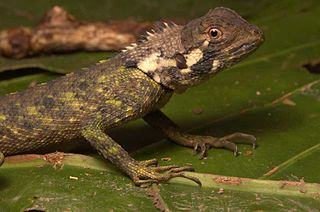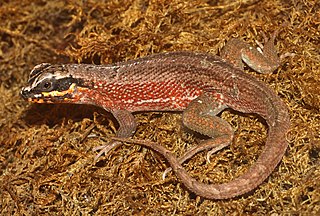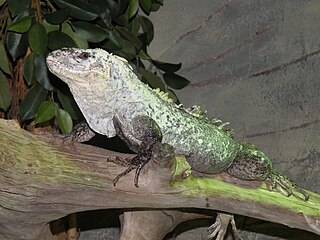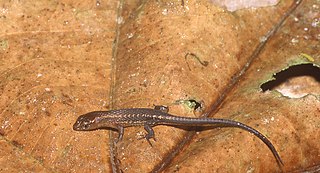
The Iguanidae is a family of lizards composed of the iguanas, chuckwallas, and their prehistoric relatives, including the widespread green iguana.

Plica is a genus of tropidurid lizards found in South America and the Caribbean. Species in the genus Plica are arboreal, medium-sized lizards.

Iguania is an infraorder of squamate reptiles that includes iguanas, chameleons, agamids, and New World lizards like anoles and phrynosomatids. Using morphological features as a guide to evolutionary relationships, the Iguania are believed to form the sister group to the remainder of the Squamata, which comprise nearly 11,000 named species, roughly 2000 of which are iguanians. However, molecular information has placed Iguania well within the Squamata as sister taxa to the Anguimorpha and closely related to snakes. The order has been under debate and revisions after being classified by Charles Lewis Camp in 1923 due to difficulties finding adequate synapomorphic morphological characteristics. Most iguanians are arboreal but there are several terrestrial groups. They usually have primitive fleshy, non-prehensile tongues, although the tongue is highly modified in chameleons. Today they are scattered occurring in Madagascar, the Fiji and Friendly Islands and Western Hemisphere.

Ctenosaura bakeri, also known as the Utila spiny-tailed iguana, Baker's spinytail iguana, swamper or wishiwilly del suampo, is a critically endangered species of spinytail iguana endemic to the island of Utila, one of the Islas de la Bahía off the coast of Honduras in the Caribbean.
Plasmodium minasense is a parasite of the genus Plasmodium subgenus Carinamoeba.

Ameiva ameiva, also known as the giant ameiva, green ameiva, South American ground lizard, or Amazon racerunner, is a species of lizard in the family Teiidae found in Central and South America, and some Caribbean Islands.
Plasmodium guyannense is a parasite of the genus Plasmodium subgenus Sauramoeba. As in all Plasmodium species, P. guyannense has both vertebrate and insect hosts. The vertebrate hosts for this parasite are reptiles.
Plasmodium vacuolatum is a parasite of the genus Plasmodium.

Oplurus cuvieri, commonly known as the collared iguana, the collared iguanid lizard, Cuvier's Madagascar skink, Cuvier's Madagascar swift, and the Madagascan collared iguana, is a species of arboreal lizard in the family Opluridae. The species is native to Madagascar and Comoros. There are two recognized subspecies. O. cuvieri is the largest of six species in the genus Oplurus.
In the 10th edition of Systema Naturae, Carl Linnaeus described the Amphibia as:
Animals that are distinguished by a body cold and generally naked; stern and expressive countenance; harsh voice; mostly lurid color; filthy odor; a few are furnished with a horrid poison; all have cartilaginous bones, slow circulation, exquisite sight and hearing, large pulmonary vessels, lobate liver, oblong thick stomach, and cystic, hepatic, and pancreatic ducts: they are deficient in diaphragm, do not transpire (sweat), can live a long time without food, are tenatious of life, and have the power of reproducing parts which have been destroyed or lost; some undergo a metamorphosis; some cast (shed) their skin; some appear to live promiscuously on land or in the water, and some are torpid during the winter.

Uracentron flaviceps, the tropical thornytail iguana or Amazon thornytail iguana is an elusive species of medium-sized arboreal lizard found in the tropical lowlands of the Amazon Rainforest. The species was described by French zoologist Alphone Guichenot in 1855. They are considered to be ant specialists and exhibit communal nesting and a harem-style breeding system in which one male mates with and attends to multiple females. Study of this species has been impeded by difficulties collecting and observing them.
The green thornytail iguana is an arboreal species of lizard from the Amazon rainforest and forests in the Guiana Shield. It is found in Colombia, Guyana, Suriname, French Guiana, northeastern Peru, southern Venezuela, and northern Brazil. As in U. flaviceps, U. azureum primarily feeds on ants.

Kentropyx calcarata, commonly known as the striped forest whiptail, is a species of lizard endemic to South America.

Tropidurus torquatus is a species of lizard in the family Tropiduridae, the Neotropical ground lizards. Its common name is Amazon lava lizard. The species is endemic to South America. There are no subspecies.

Alopoglossus angulatus, known commonly as the northern teiid, is a species of lizard in the family Alopoglossidae. The species is endemic to northern South America.

Uranoscodon is a monotypic genus of iguanomorph lizard belonging to the family Tropiduridae, the Neotropical ground lizards. Its sole member, Uranoscodon superciliosus, is commonly known as the diving lizard, brown tree climber or mophead iguana. It is found near water in the Amazon rainforest of South America.

Plica umbra, the blue-lipped tree lizard or harlequin racerunner, is a species of lizard in the family Tropiduridae. The species is found in South America.
Stenocercus guentheri, also known commonly as Günther's whorltail iguana and la guagsa de Günther in South American Spanish, is a species of lizard in the family Tropiduridae. The species is native to northwestern South America.













